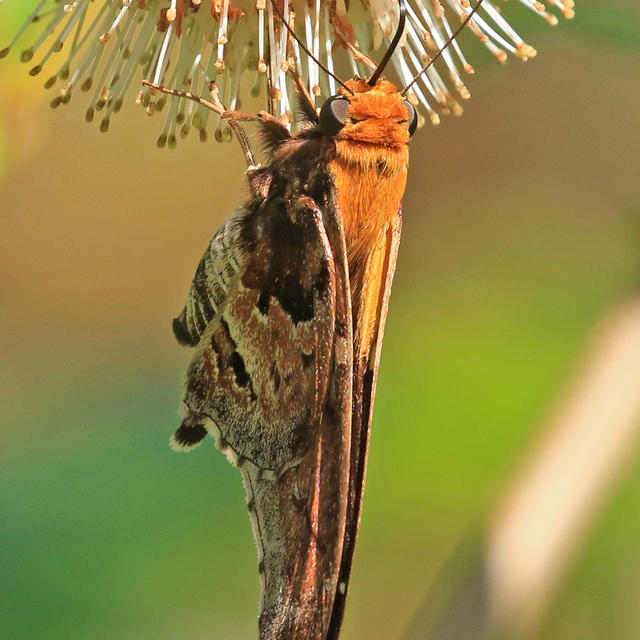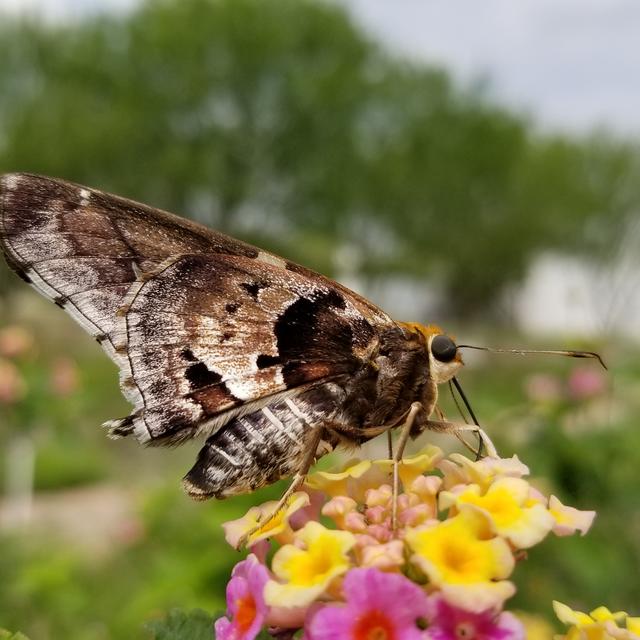Mercurial Skipper
Proteides mercurius (Fabricius, 1787)
Family: Hesperiidae
Subfamily: Pyrginae
Identification: Head and thorax are bright orange above; forewings are elongate. Upperside of wings is brown with golden orange at the bases. Underside is chestnut brown with white frosting on outer edges; center of hindwing has an indistinct white mark.
Wing Span: 2 1/4 - 2 3/4 inches (5.8 - 7 cm).
Life History: Adults bask with their wings spread open. Males perch to find females. Caterpillars rest in leaf shelters and come out at night to eat leaves.
Flight: April-May in southern Florida, April-October in South Texas, all year in Mexico.
Caterpillar Hosts: Tree and vine legumes including senna (Cassia), cow pea (Vigna), and Muellera.
Adult Food: Flower nectar.
Habitat: Near streams in lowland tropical forests, particularly in edges and openings.
Range: Argentina north through Central America to Mexico and the West Indies. Strays to Florida, Louisiana, and Texas.
Conservation: Not usually required.
NCGR: G5 - Demonstrably secure globally, though it may be quite rare in parts of its range, especially at the periphery.
Management Needs: None reported.
Comments: NULL
Get your BAMONA Gear!
Please donate!
We depend on donations to keep Butterflies and Moths of North America freely available. We want to express our gratitude to all who showed their support by making a contribution this year. You can donate to support this project at any time.
Advertise with us!
Do you have a product or service that you think would interest BAMONA users? If you would like to advertise on this website, contact us by email, or use the contact form and select the "Advertising" category.
Verified Sightings
Displaying 1 - 24 of 26 verified sightings

Observation date: Jun 17, 2015
Submitted by: Teresa Jacobs
Region: Yucatan, Mexico
Verified by: Paul Prappas
Verified date: Oct 12, 2022

Observation date: Mar 21, 2018
Submitted by: Craig M Lipski
Region: Hidalgo County, Texas, United States
Verified by: stomlins701
Verified date: Oct 18, 2018

Observation date: Mar 07, 2018
Submitted by: Craig M Lipski
Region: Hidalgo County, Texas, United States
Verified by: stomlins701
Verified date: Oct 18, 2018

Observation date: Jun 07, 2018
Submitted by: jehartg
Region: East Baton Rouge Parish, Louisiana, United States
Verified by: stomlins701
Verified date: Aug 09, 2018

Observation date: Mar 13, 2018
Submitted by: Christinalea
Region: Hidalgo County, Texas, United States
Verified by: stomlins701
Verified date: Jul 01, 2018

Observation date: Mar 16, 2018
Submitted by: Kurt R. Schwarz
Region: Hidalgo County, Texas, United States
Verified by: stomlins701
Verified date: Mar 27, 2018

Observation date: Jan 04, 2018
Submitted by: pedrogenaro
Region: Dominican Republic
Verified by: Doug Taron
Verified date: Feb 05, 2018

Observation date: Jul 07, 2016
Submitted by: LLJohnson
Region: Dominican Republic
Verified by: Doug Taron
Verified date: Dec 01, 2017

Observation date: Sep 03, 2016
Submitted by: ertpigg@swbell.net
Region: Texas, Williamson County, United States
Verified by: stomlins701
Verified date: Dec 29, 2016

Observation date: Dec 27, 2013
Submitted by: DJHiker
Region: Pinar del Rio, Cuba
Verified by: Doug Taron
Verified date: Mar 23, 2014

Observation date: Feb 11, 2014
Submitted by: Doug Taron
Region: Jalisco, Mexico
Verified by: Doug Taron
Verified date: Feb 24, 2014
Observation date: Sep 12, 1992
Submitted by: legacy.reporter (H. Brodkin & R. Bailowitz)
Region: Santa Cruz County, Arizona, United States
Verified by: Ken Davenport (Ken Davenport)
Verified date: Dec 01, 2012

Observation date: unknown
Submitted by: paulopler (Paul Opler)
Region: United States
Verified by: BAMONA
Verified date: Sep 06, 2010
Observation date: Sep 12, 1992
Submitted by: legacy.reporter (Bailowitz & Brodkin)
Region: Santa Cruz County, Arizona, United States
Verified by: legacy.verifier (Richard Bailowitz)
Verified date: Jan 07, 2008
Observation date: Oct 15, 2006
Submitted by: legacy.reporter (Mike Overton, Paul Opler)
Region: San Luis Potosi, Mexico
Verified by: legacy.verifier (Mike Overton)
Verified date: Sep 11, 2007
Observation date: Oct 16, 2006
Submitted by: legacy.reporter (Mike Overton, Paul Opler)
Region: Tamaulipas, Mexico
Verified by: legacy.verifier (Mike Overton)
Verified date: Sep 11, 2007
Observation date: Oct 15, 2006
Submitted by: legacy.reporter (Mike Overton, Paul Opler)
Region: Tamaulipas, Mexico
Verified by: legacy.verifier (Mike Overton)
Verified date: Sep 11, 2007
Observation date: May 22, 2002
Submitted by: legacy.reporter (North American Butterfly Association (NABA) of South Texas))
Region: Hidalgo County, Texas, United States
Verified by: legacy.verifier (North American Butterfly Association (NABA) of South Texas))
Verified date: Jan 29, 2007
Observation date: Oct 18, 2003
Submitted by: legacy.reporter (North American Butterfly Association (NABA) of South Texas))
Region: Cameron County, Texas, United States
Verified by: legacy.verifier (North American Butterfly Association (NABA) of South Texas))
Verified date: Jan 29, 2007
Observation date: unknown
Submitted by: legacy.reporter
Region: Galveston County, Texas, United States
Verified by: legacy.verifier
Verified date: Dec 31, 2004
Observation date: unknown
Submitted by: legacy.reporter
Region: Sinaloa, Mexico
Verified by: legacy.verifier
Verified date: Dec 31, 2004
Observation date: unknown
Submitted by: legacy.reporter
Region: Texas, Kerr County, United States
Verified by: legacy.verifier
Verified date: Dec 31, 2004
Observation date: unknown
Submitted by: legacy.reporter
Region: Santa Cruz County, Arizona, United States
Verified by: legacy.verifier
Verified date: Dec 31, 2004
Observation date: unknown
Submitted by: legacy.reporter
Region: Tamaulipas, Mexico
Verified by: legacy.verifier
Verified date: Dec 31, 2004
- 1 of 2
- next ›


